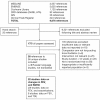Relationship between FEV1 change and patient-reported outcomes in randomised trials of inhaled bronchodilators for stable COPD: a systematic review
- PMID: 21477298
- PMCID: PMC3090353
- DOI: 10.1186/1465-9921-12-40
Relationship between FEV1 change and patient-reported outcomes in randomised trials of inhaled bronchodilators for stable COPD: a systematic review
Abstract
Background: Interactions between spirometry and patient-reported outcomes in COPD are not well understood. This systematic review and study-level analysis investigated the relationship between changes in FEV1 and changes in health status with bronchodilator therapy.
Methods: Six databases (to October 2009) were searched to identify studies with long-acting bronchodilator therapy reporting FEV1 and health status, dyspnoea or exacerbations. Mean and standard deviations of treatment effects were extracted for each arm of each study. Relationships between changes in trough FEV1 and outcomes were assessed using correlations and random-effects regression modelling. The primary outcome was St George's Respiratory Questionnaire (SGRQ) total score.
Results: Thirty-six studies (≥ 3 months) were included. Twenty-two studies (23,654 patients) with 49 treatment arms each contributing one data point provided SGRQ data. Change in trough FEV1 and change in SGRQ total score were negatively correlated (r = -0.46, p < 0.001); greater increases in FEV1 were associated with greater reductions (improvements) in SGRQ. The correlation strengthened with increasing study duration from 3 to 12 months. Regression modelling indicated that 100 mL increase in FEV1 (change at which patients are more likely to report improvement) was associated with a statistically significant reduction in SGRQ of 2.5 (95% CI 1.9, 3.1), while a clinically relevant SGRQ change (4.0) was associated with 160.6 (95% CI 129.0, 211.6) mL increase in FEV1. The association between change in FEV1 and other patient-reported outcomes was generally weak.
Conclusions: Our analyses indicate, at a study level, that improvement in mean trough FEV1 is associated with proportional improvements in health status.
Figures


References
-
- Global initiative for chronic obstructive lung disease (GOLD) Global Strategy for the Diagnosis, Management, and Prevention of chronic obstructive pulmonary disease. http://www.goldcopd.com Updated 2009. [accessed 10 June 2010]. - PubMed
-
- Jones PW, Quirk FH, Baveystock CM, Littlejohns P. A self-complete measure of health status for chronic airflow limitation. The St. George's Respiratory Questionnaire. Am Rev Respir Dis. 1992;145(6):1321–1327. - PubMed
-
- Guyatt GHF, Patrick DL. Measuring health-related quality of life. Ann Intern Med. 1993;118(8):622–629. - PubMed
-
- Stahl E, Wadbo M, Bengtsson T, Strom K, Lofdahl KC-G. Health-related quality of life, symptoms, exercise capacity and lung function during treatment for moderate to severe COPD. J Outcomes Res. 2001;5:11–24.
Publication types
MeSH terms
Substances
LinkOut - more resources
Full Text Sources
Medical

